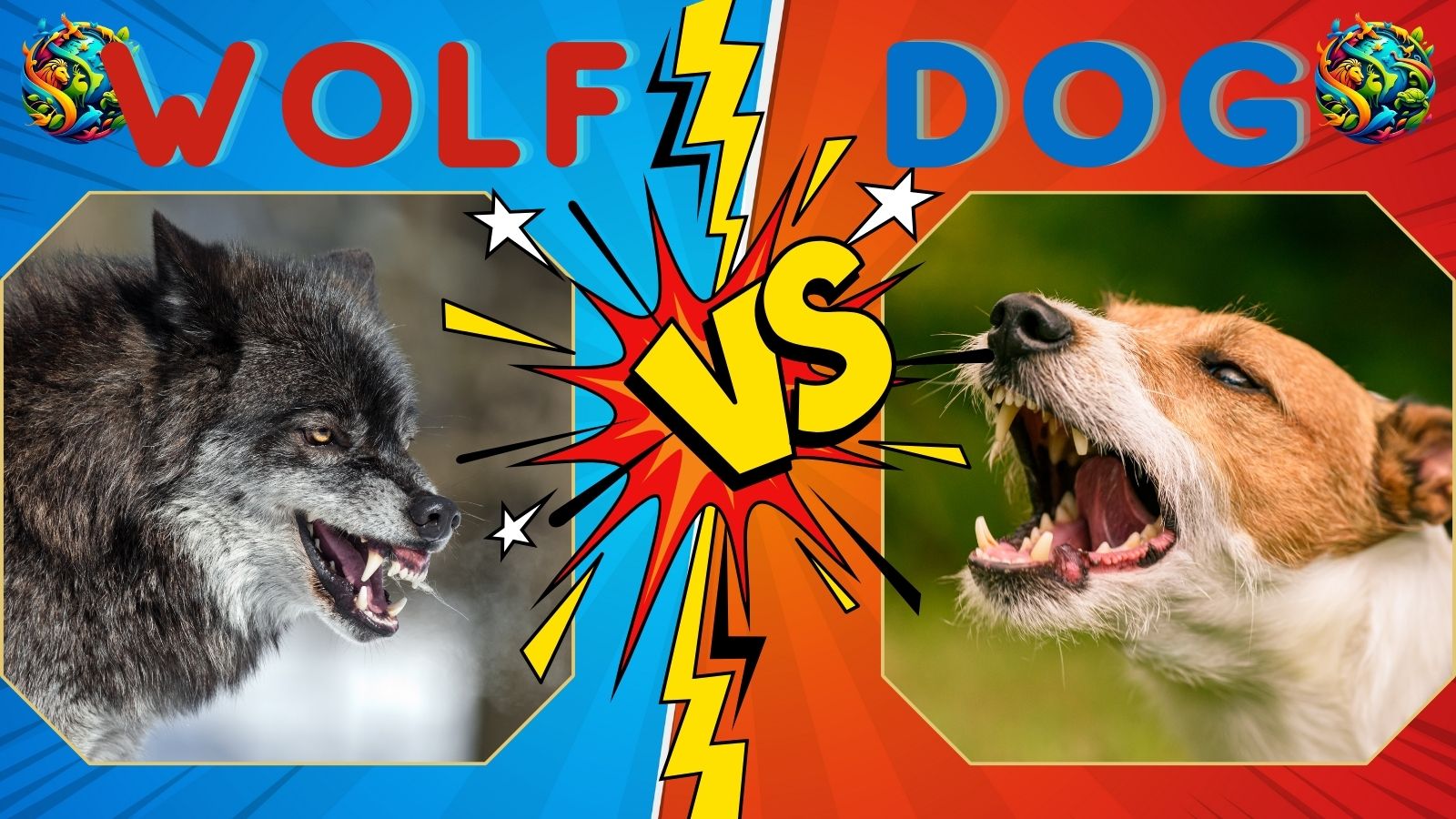Wolf vs Dog: The Ultimate Canine Showdown
Both wolves and dogs are members of the same family called Canidae, but their separation of many thousands of years of domestication puts the two animals worlds apart. While the wolf has lived a wild life full of survival, they are the ancestors of dogs, which, throughout history, have lived with humans. Which one performs better in regard to bite strength, personality, and survival is what we seek to find out.
In a face-off between dog and wolf, this article will analyze the various physical features, social behaviors, and defensive strategies employed by each species to understand the winner of such an enigmatic battle.
Introduction: The Wild and The Tame (Wolf vs Dog)
Due to years of domestication, every breed of dog from doberman to chihuahua differs in regards to behavior, character, and even size. At the same time, every wolf out there is an independent, fast, strong, and agile animal. Still, dogs and wolves show many similarities regardless of the amount of domestication.
What occurs when we match the world’s supreme canine hunter, the wolf, against a dog, man’s best friend? Is the wolf’s wild nature too much for even the fittest of dogs? Or does the loyalty and domesticated skills of a dog give him an advantage?
Basic Information on the Animals (Wolf vs Dog)
The Wolf
Scientific Name: Canis lupus

Wolves are social canids and the most specialized members out of the entire Canidae family. They mainly reside in the unexplored, commonly wild parts of the world like forests, tundras and grasslands. Their most recognized type, the gray wolf, has a thick coat which is long with large paws and long legs, all adapted to live in the fierce cold of winter.
- Size: Wolves usually weigh around 70 to 120 pounds and can achieve a length of 6.5 feet while including their tail.
- Diet: Carnivorous wolves form packs in order to hunt deer, moose, and even elk.
- Behavior: Wolves are social creatures obligate to live in packs headed by an alpha male and a female wolf. Teamwork is essential for hunting and defense.
The Dog

Scientific Name: Canis lupus familiaris
Dogs evolved from wolves and were domesticated many years ago. Selective breeding has resulted in a stunning myriad of dog breeds, each displaying unique characteristics and temperament. While some wild dogs do exist, the vast majority of domesticated dogs are kept as companions or as service animals.
- Height: Depending on the breed, dogs can vary immensely in height. Breeds such as Chihuahua can weigh as low as 2 pounds, while breeds like Great Danes can weigh over 200 pounds.
- Diet: Dogs are omnivores, eating animals, plants, and grains. Different from wolves, a large population of dogs have no qualms consuming the food offered to them by humans.
- Behavior: Dogs have been bred for multiple purposes which include hunting, livestock herding, companionship, and personal safety. Compared to wolves, dogs are more social and friendly to a lot of humans due to being raised from an early age in human populations.
Key Comparisons of Wolf vs Dog
Strength & Power
- Wolf: One of the major defining characteristic of wolves are attributed to their strength and stamina. In terms of physicality, wolves are muscular and strong-bodied with well-defined jaws, allowing for effortless hunting and survival in endemic regions. Wolves tend to run between 35-40 mph and possess a bite force of around 1500 psi.
- Dog: Even though Alaskan malamute and Rottweiler domesticated dogs are strong, they overall are weaker and smaller than wolves. In comparison to wolves, the largest dogs like Great Danes have quite a lesser bite force that is approximately 200 to 300 psi.
Winner: Wolf. The wolf has the advantage. It will overpower most dog breeds with physical characteristics such as raw strength, large size, and a large bite force.
Speed & Agility of Wolf vs Dog
- Wolf: Wolves can run at an incredible speed of 35 mph, which is further augmented by their exceptional acceleration and agility in direction changes while sprinting after prey.
- Dog: Certain dog breeds, particularly Greyhounds and Whippets, are capable of short speed bursts reaching 45mph. However, dogs bred for companionship or strength are less agile compared to wolves.
Winner: Dog (in speed). Wolves outperform dogs in terms of stamina and long distance running, while dogs dominate wolves in short distance speed bursts.
Skills & Tactics of Hunting of Wolf vs Dog
- Wolf: A Wolfe possesses the ability to coordinate the location and capture of larger prey to turn it into food for itself. This primal requires complex behavior as they are located within a hierarchy of a pack that works together to bring down prey that is substantially larger and stronger than itself. All of their hunting approaches combine teamwork, collaboration, and skill. Their tactics use powerful strategies that make use of high endurance in order to exhaust the prey then attack at the most suitable moment.
- Dog: Most dogs have been domesticated and possess the ability to utilize their basic hunting instinct, like a retriever and hound dogs. However, these familiars of tiger possess extremely lower levels of team skill and survival ability as dogs have been trained over centuries. A border collie is capable of fetching a ball and obeys commands, but relies on humans for survival which makes them extremely different from a wolf. A wolf on the other hand is capable of outmaneuvering the dog with teamwork and the rush of adrenaline due to their survival instinct, unlike dogs.
Winner: Wolves. Wolves are bred to hunt and utilize developed strategies and collaboration. This not being found in domesticated dogs, they lose against wolves.
Intelligence & Adaptability of Wolf vs Dog
- Wolf: Wolves can adapt to a variety of environments including forests and tundras as they are some of the smartest animals in the world. A wolf’s territory has internal boundaries which enables them to cooperate with each other and allows movement around other pack members. Complex social structures enable a wolf to thrive and enables them to formulate a strategy which works best within their pack.
- Dog: Other breeds of dog like border collies and poodles require great levels of intelligence as it is extremely difficult to train a dog without any obedience. Domestication has altered some forms of intelligence regarding survival skills and made them interdependent on humans for any of their needs and puts them below wolves who don’t need to rely on any form of civilization.
Winner: Tie. Wolves tend to have a lot of resourcefulness in the wild, while many dog breeds display their intelligence in a multitude of ways, especially during training.
Wolf vs Dog Fight Scenario:
Picture a wolf and a domesticated dog face off. If a dog were to fight a wolf, then the wolf would likely have the upper hand in overall physical strength, bite force, and even survival instincts. Wolves are vicious and methodical fighters as they depend on their large size and brute force to face threats.
However, larger and more powerful dogs like Rottweiler, Alaskan Malamute, and Pitbulls would certainly give the wolf a challenge. Those dogs have the muscular build along with sufficient bite force which, if used appropriately, can pose a serious threat to the wolf. How dominant a particular breed of dog is during a fight will depend on its size, breed, and level of experience along with the facilities where the fight occurs.
More often than not, the wolf is bound to win because of its wild instincts, strategic mind, and stronger bite force.
Winner: Wolves. A trained and strong dog may appear to put up a fight but a wolf’s mixture of strength, endurance, and battle experience would inevitably win.
To Finish: A Final Comment Passing Judgment on Who Would Win Wolf vs Dog
After taking into account all the factors, the battle of the wolf versus dog ends in the following defeats and victories:
- Physical Power → Wolf
- Speed → Dog (short sprints)
- Stamina → Wolf
- Intelligence → Tie
- Hunting Strategy and Plan → Wolf
- Adaptability and Versatility → Wolf
Final Verdict/Winner: Dog during training and Wolf during combat.
I believe the wolf has a good chance of winning a one vs one encounter due to being physically stronger, hunting with superior skill, and having greater strength. However, with excellent training and strength, some domesticated dog breeds can survive especially if they are fighting other dogs or when there is a human involved. Overall, it is evident that dogs have evolved to co-exist with humans, but the wolf is still the better predator in nature.





Great post, I think website owners should learn a lot from this web blog its real user genial.
Does your blog have a contact page? I’m having trouble locating it but, I’d like to shoot you an e-mail. I’ve got some suggestions for your blog you might be interested in hearing. Either way, great site and I look forward to seeing it develop over time.